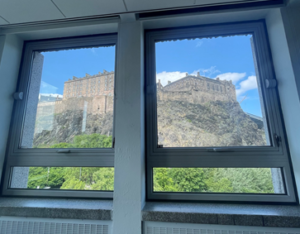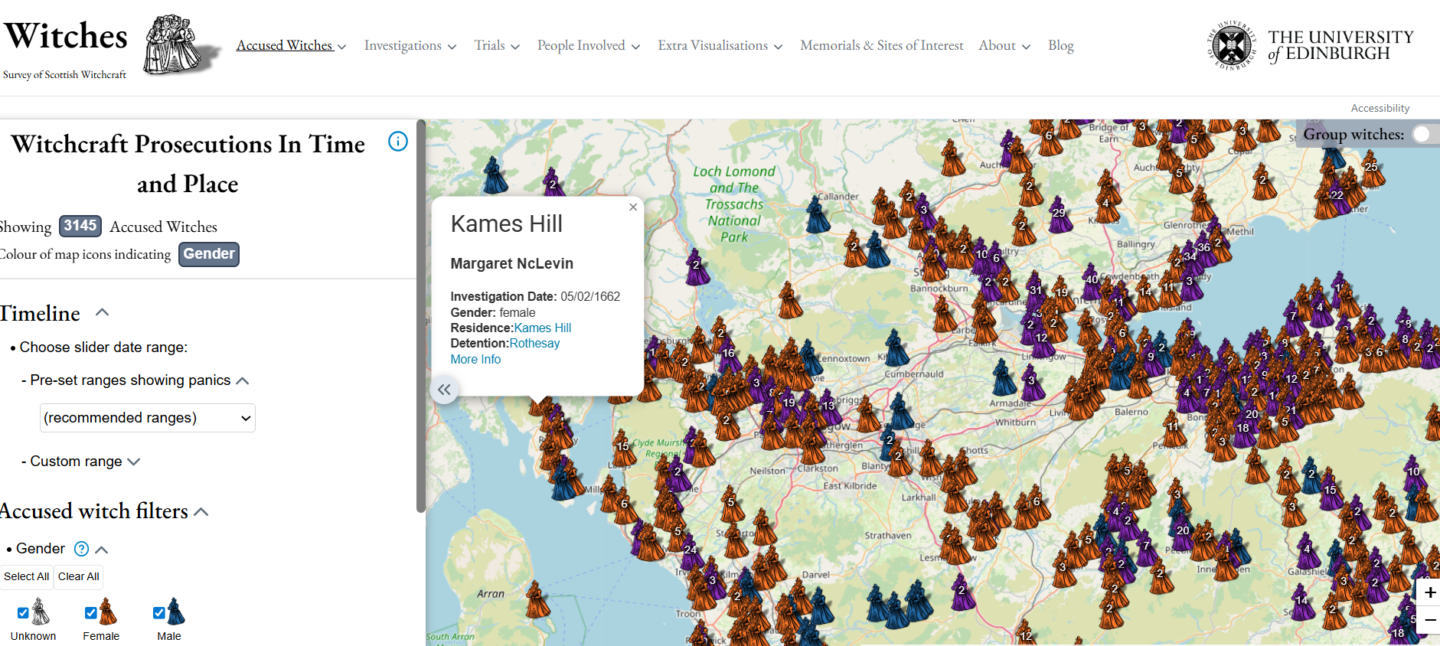This post was written by LLB student Dervla Craig on her first month as Information and Data Literacy intern this Summer.
My name is Dervla and I am going into my second year of the Graduate LLB at the University of Edinburgh. This summer I am doing a 12-week internship with the University’s Information Services Group (ISG) on one of the most fascinating projects I have ever had the opportunity to be a part of: the Accused Witches of Scotland project.
I am one of a long line of interns who has been involved in this project each year since 2019, which aims to commemorate and spread awareness about those who were persecuted as witches in Scotland during the 16th to 18th centuries. While previous interns have primarily been focused on processing and importing data from the University’s landmark The Survey of Scottish Witchcraft database (2003) into Wikidata and created our witches website with new map and timeline visualisations, this year my role looks a bit different.
My remit for the 12 weeks is to prepare a bid to the National Lottery Heritage Fund to secure funding for what we hope can be the next phase of the project. Our goal is to preserve the accused witches’ data in the long-term and ensure that people can connect with and participate in this heritage now and in the future. As it has come to the end of my first month, I wanted to join the tradition of blogging about my internship experience so far.
Getting to know the individual stories of the accused
My first week was spent diving down the rabbit hole to explore all there is to learn about the Scottish witch trials. If you had asked me to describe an accused witch before this week, I would’ve told you they wore a pointy hat and flew around on a broomstick. I couldn’t have been more wrong! Now when I picture these women, they look like my mother, or my grandmother, or me. They were ordinary people who suffered an egregious injustice, and I was extremely moved when learning about their stories.
Some of the most valuable tools for my research included The Survey of Scottish Witchcraft, created by Julian Goodare, a history professor at the University of Edinburgh, and his team in the late 90’s, and the interactive witches map resource created by Emma Carroll, a geography student and our former Data Visualisation intern, and our late developer colleague Richard Lawson in September 2019. The Survey made use of the historic records of all the accused witches in Scotland between 1563 – 1736 and organised the details into a MS Access 1997 database, and our new 2019 map brings this data to life in a new and engaging way through importing the data into Wikipedia’s sister project, Wikidata, as linked open machine-readable data.
Learning about the great work that has been done previously definitely made me realise I have a lot to live up to but also motivated me to give it my all in the next twelve weeks and hopefully produce an end result that meets the standards of my predecessors.
Writing a National Lottery Heritage Fund bid
The next thing to familiarise myself with before I could dive into my writing was the bid itself. I spent a few days combing through the NLHF website to understand what it is they are looking for and how our project fits those needs. By getting to know my audience, I could ensure that my writing was intriguing, evidence-based and persuasive. I quickly found out that before submitting the 10,000-word application, I must submit a 1000-word ‘Expression of Interest’. This EoI asks questions about the heritage of the project, what our project aims to achieve, and why it is needed now. At this point, I felt I could write a dissertation for each of these questions, so the tight word count was my biggest enemy. I had lots of help from some lovely colleagues who offered their feedback and advice, including the Project Director of the Survey of Scottish Witchcraft, Professor Julian Goodare. After many tweaks and a few redrafts, I am happy to say at the end of week four that the EoI is pretty much ready to go.
Exploring avenues for community engagement
Alongside writing, writing and more writing, I have also been brainstorming ideas for the community engagement side of our project. There have been so many great ideas by the team which have led to interesting and helpful discussions with different people and organisations, including the National Museum of Scotland, Reforesting Scotland, and some really talented artists. Excitingly, most of the responses we have received have been positive and enthusiastic. In the upcoming weeks, I hope to visit some of these places and see firsthand the primary sources from the witch trials.
Workshops and all-staff events
Another educational and fun aspect of my experience so far, outside of my bid writing role, has been the plethora of events hosted by ISG. In the past month I have taken part in ‘intern welcome’ socials, Wikipedia writing workshops and even a workshop on an introduction to blogging! Alongside these, I have also attended two all-staff events, one for all Information Services Group (ISG) staff and one for the Learning, Teaching and Web (LTW) division. Not only have I learned so much about the behind-the-scenes and the people who have made my studies possible for the past five years, but these events have also been an opportunity to get to know more of my colleagues and socialise with other interns. At ISG there is a strong emphasis on having a healthy work-life balance and making sure that you and those around you have what you need to produce your best work.

View of Edinburgh Castle from Floor K, Argyle House. CC-BY-SA by Dervla Craig.
In conclusion, I have had an amazing first month as an intern with the University of Edinburgh. I have learned a lot, met new people, and pushed myself outside of my comfort zone. Plus the amazing view of Edinburgh Castle from Floor K has been a real motivator to work from the office and not from home! I am nothing but hopeful that the next eight weeks will be even more exciting and productive, and that I can blog again soon with positive updates!
P.S. If you haven’t already, definitely visit The Survey of Scottish Witchcraft and the Map of Accused Witches in Scotland websites! They are both amazing (and important) educational resources that I could browse for hours (and have).



Leave a Reply